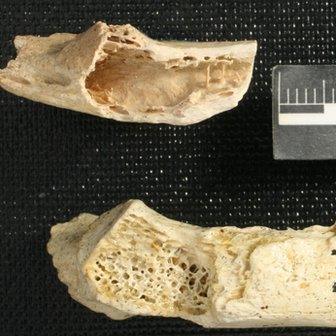Neanderthal clues to cancer origins
- Published

Abnormal bone of the Neanderthal (above) compared with normal Neanderthal specimen (below)
A Neanderthal living 120,000 years ago had a cancer that is common today, according to a fossil study.
A fossilised Neanderthal rib found in a shallow cave at Krapina, Croatia, shows signs of a bone tumour.
The discovery is the oldest evidence yet of a tumour in the human fossil record, say US scientists.
The research, published in the journal PLOS One, gives clues to the complex history of cancer in humans.
Until now, the earliest known bone cancers have been identified in ancient Egyptian remains from about 1,000-4,000 years ago.
"It's the oldest tumour found in the human fossil record," Dr David Frayer, the University of Kansas anthropologist who led the US team, told BBC News.
"It shows that living in a relatively unpolluted environment doesn't necessarily protect you against cancer, even if you were a Neanderthal living 120,000 years ago."
Complex history
The fossil was uncovered from an important archaeological site that has yielded almost 900 ancient human bones, along with stone tools.
The cancerous rib is an incomplete specimen, so the overall health impact of the tumour on the individual cannot be established.
The tumour was diagnosed by a medical radiologist from X-rays and CT scans.
Although efforts to extract ancient DNA from the Neanderthal fossil have proved unsuccessful, the researchers hope other fossils may shed light on cancer in prehistoric humans.
Commenting on the study, Kat Arney, science information manager at Cancer Research UK, said: "Some people think that cancer is only a modern disease, but there's evidence from fossils, bones and mummies that it's actually many thousands of years old.
"So this discovery isn't entirely surprising, even though such finds are very rare, but it helps to shed light on the complex history of cancer in humans and our ancient relatives."
- Published13 March 2013